
Platanthera praeclara, known as the western prairie fringed orchid and the Great Plains white fringed orchid, is a rare and threatened species of orchid native to North America.
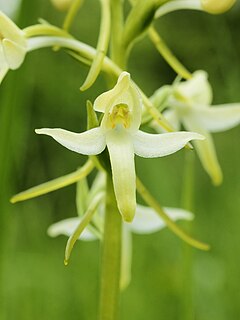
The genus Platanthera belongs to the subfamily Orchidoideae of the family Orchidaceae, and comprises about 150 species of orchids. The members of this genus, known as the butterfly orchids or fringed orchids, were previously included in the genus Orchis, which is a close relative. They are distributed throughout the temperate regions of the Northern Hemisphere. They are terrestrial and have tubercules.
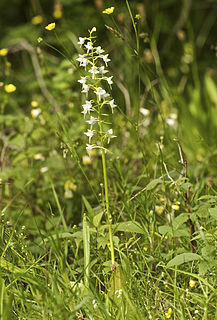
Platanthera chlorantha, commonly known as greater butterfly-orchid, is a species of orchid in the genus Platanthera. It can be found throughout Europe and Morocco. The name Platanthera is derived from Greek, meaning "broad anthers", while the species name, chlorantha, means "green-flowered".

Platanthera blephariglottis, commonly known as the white fringed orchid or white-fringed orchis, is a species of orchid of the genus Platanthera. It is considered to be an endangered species in Connecticut and Ohio, a threatened species in Florida, Maryland and Rhode Island, exploitably vulnerable in New York, and susceptible to be threatened in Québec.

Platanthera psycodes, commonly called lesser purple fringed orchid or small purple-fringed orchid, is a species of orchid, genus Platanthera, occurring from eastern Canada to the east-central and northeastern United States. It is imperiled in Illinois, Tennessee, North Carolina, and Kentucky.
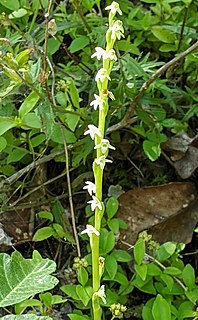
Platanthera ephemerantha is a species of orchid known by the common names whiteflower rein orchid, slender white piperia, and white-flowered piperia. It is native to western North America from Alaska to the San Francisco Bay Area, where it grows in coniferous forests and other habitat in coastal and inland mountain ranges within 150 kilometers of the coast. It grows erect to about half a meter in maximum height from a bulbous caudex. The basal leaves are up to 18 centimeters long by 3 wide. Leaves higher on the stem are much reduced. The upper part of the stem is a spikelike inflorescence of up to 100 small flowers, mostly arranged along one side of the stem. The fragrant, honey-scented flowers are whiter than those of other Platanthera, but sometimes green-tinged or -veined, or green with white margins. The status of this species in the wild is difficult to determine because most populations are small and may produce flowers only rarely.
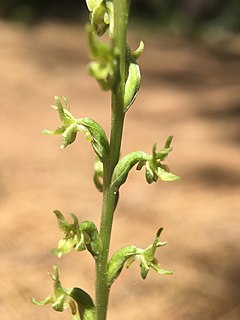
Platanthera colemanii is a rare species of orchid known by the common names Coleman's piperia and Coleman's rein orchid. It is endemic to California, where it is known from scattered occurrences along the Sierra Nevada and one disjunct location in Colusa County, California. It grows in coniferous forests and chaparral in deep sandy substrates. It was differentiated from the very similar Platanthera unalascensis in 1993.
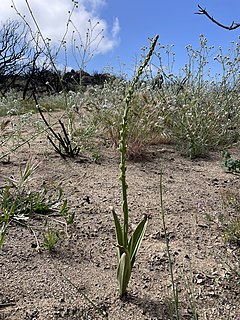
Platanthera cooperi is an uncommon species of orchid known by the common names Cooper's rein orchid and chaparral rein orchid.
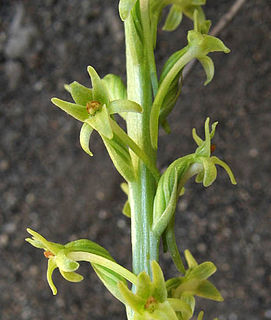
Platanthera elongata is a species of orchid known by the common names denseflower rein orchid, chaparral orchid and wood rein-orchid. It is native to western North America from British Columbia and Montana to southern California, where it grows in mountain forests and scrub habitat. This orchid grows erect to about 1.3 meters in maximum height from a bulbous caudex, its stem becoming narrow toward the tip. The basal leaves are up to 30 centimeters long by 6.5 wide. Leaves higher on the stem are much reduced. The upper part of the stem is a spikelike inflorescence of many small green flowers which are sometimes densely arranged. They are sometimes faintly and variably fragrant in the evenings. The spur on each flower may be up to 1.5 centimeters long.

Platanthera michaelii is an uncommon species of orchid known by the common names Michael's rein orchid and Michael's piperia. It is endemic to California, where it is known from the coastal plains, hills, and mountains, and the Sierra Nevada foothills. It can be found in varied habitat, including scrub, woodland, and forest. This orchid grows erect to about 70 centimeters in maximum height from a bulbous caudex. The basal leaves are up to 24 centimeters long by 5 wide. Leaves higher on the stem are much reduced. The upper part of the stem is a spikelike inflorescence of many yellow-green flowers which are fragrant in the evenings.

Platanthera transversa is a species of orchid known by the common names royal rein orchid and flat spurred piperia.

Platanthera unalascensis is a species of orchid known by the common names slender-spire orchid, Alaska piperia and Alaska rein orchid. It is native to much of western North America from Alaska to the southwestern United States, as well as eastern sections of Canada and the Great Lakes. It can be found in forest, woodland, and scrub habitat, often in dry areas. This orchid grows erect to about 70 centimeters in maximum height. The basal leaves are up to 15 centimeters long by 4 wide. Leaves higher on the stem are much reduced. The upper part of the stem is a slender, spikelike inflorescence of widely spaced translucent green flowers. The flowers are fragrant in the evenings, with a musky, soapy, or honeylike scent. The plant is variable in size, stem thickness, density of inflorescence, petal shape, and scent. Plants of the coast ranges and the Pacific Northwest are stouter and have broader sepals and petals than do interior and montane forms.

Platanthera sparsiflora is a species of orchid known by the common name sparse-flowered bog orchid. It is native to the forests and meadows of the western United States, and also south to Baja California.
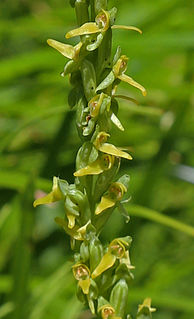
Platanthera tescamnis, the intermountain bog orchid or yellow rein orchid, is a species of orchid described in 2006. The plant is well-known but had been misidentified. It is native to the Great Basin and Colorado Plateau of the western United States, where it grows in warmer, drier habitat than most related orchids.

Platanthera integrilabia, commonly called white fringeless orchid, is a species of flowering plant in the orchid family (Orchidaceae). It is native to the Southeastern United States. Its natural habitat is in boggy acidic seeps and flats, usually in partial open sunlight.

Platanthera clavellata, commonly known as the club-spur orchid or small green wood orchid, is a terrestrial orchid of North America.

Platanthera brevifolia, the shortflowered bog orchid or short-leaf bog orchid, is a terrestrial orchid of North America.

Platanthera purpurascens, the purple petal bog orchid, is a terrestrial orchid of North America.

Platanthera pallida, commonly known as pale fringed orchid, is a rare orchid of North America with the only known occurrences on Long Island.

Platanthera chorisiana, Chamisso's orchid or Choris' bog orchid, is a terrestrial orchid native to the United States, Canada, Russia and Japan.




















